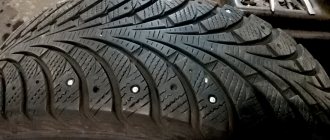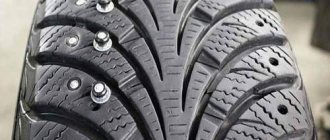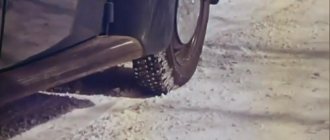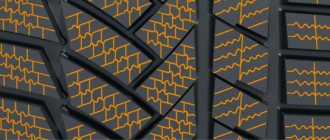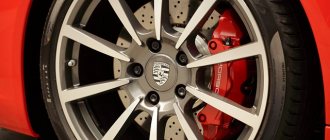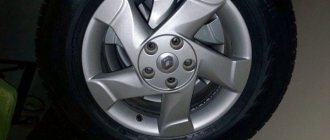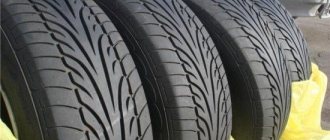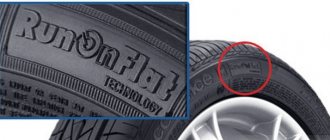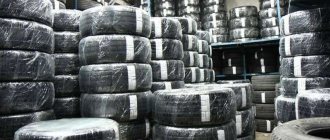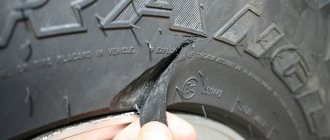Many drivers know firsthand that even the most expensive tires from well-known manufacturers deteriorates very quickly – the spikes fly out much faster than the manufacturer promises. The problem is that after a certain period of use of winter wheels, the tread remains just like new, but there are very few studs left.
Often, many drivers, not knowing how to correct the situation, buy a new set of studded winter tires. But there are people who give it another chance and re-stud the tires. But before doing this, you need to understand all the nuances of studding.
Studded tires and non-studded tires: understanding the terms
In order not to get confused further, let's immediately decide what we are talking about.
Studless, or friction, rubber is rubber that does not have factory holes for studs.
Studded rubber is rubber that has technological holes for installing studs. By and large, this is a “spike”. But without installed spikes.
An example of the tread of studless and studded wheels
There is no need to stud the friction rubber. It is developed specifically for use without studs and undergoes appropriate testing, especially since the tread does not have special areas. Screwing in studs and other “tunings” disrupt the slat system, which can cause the car to become unstable when maneuvering.
If you bought a car with friction rubber in addition and want to switch to studs, we strongly recommend that you sell the unsuitable set and buy a suitable one. “Refinement” will only ruin the wheels.
For studded rubber, holes for studs are provided by the manufacturer. The slats system is also designed taking into account the installation of anti-slip elements, and studs should be installed in such holes without any “collective farming”.
How much does tuning cost?
Let's find out how much studding will cost. One new spike costs about 30 rubles. If all the spikes have fallen out and need to be restored, you will have to shell out about 3 thousand rubles. for one tire. But for all the spikes to fly out, this rarely happens, so in some cases, studding is a real savings. It will be possible to restore the previous appearance for 600–800 rubles.
But if your tires are all “bald”, and you bought a tire for 5-6 thousand rubles, then perhaps it makes sense to spend money. But again, just look at the condition of the tire itself - if it has not only lost its studs, but also its appearance, tread depth and has lost its properties necessary in winter, it is better to spend money on new tires. Let you choose a cheaper model, but a new one with good tread.
Tires with holes for studs or “studded”: what to choose
First understand why you are asking this question. Maybe you want to save money and choose a more affordable option? Or are you comparing “Velcro” and “studded” under equal conditions in the hope of determining which is optimal? Or want to consider installing custom studs to help your car brake better? If you recognize yourself in one of three situations, then we will analyze these cases especially for you.
You are unlikely to gain much in price. The fact is that when studding for factories, large dealers and chains, the cost of installing one stud is calculated based on tens and hundreds of thousands of tire units, amounting to no more than a few hundred rubles per wheel, depending on the “input data”. Even if you manage to save this money on a wheel without studs, you will pay incomparably more for an order of 4 tires. We believe that everyone understands that the price will include both a separate selection of studs and individual tuning for these particular tires, which often takes more time than the studding process itself.
It is also impossible to compare different types of tires. Simply because studded rubber without studs is not Velcro. It has a slightly different tread and different softness characteristics. On any surface, its results will be less satisfactory than those of friction tires and even worse than those of studded ones.
You can adequately and honestly evaluate friction with fully studded tires, as, for example, we did in a review of comparative tests from respected authoritative publications.
To install non-standard spikes you need a reason. Regular studded tires are completely suitable for use on asphalt, ice and snowy roads. Plus, it has an optimal balance between braking quality and ride comfort, studied in tests. The longer and stiffer the spikes, the more they make noise and vibrate on the asphalt.
The only reason to consider this idea: the installation of steel studs instead of homologated (provided and approved) aluminum studs by the manufacturer, as well as the installation, for example, of three-flange studs instead of single- and double-flange ones. Only in these cases, with the correct selection of studs for the tire, you will benefit in the form of a longer service life of steel compared to soft and pliable aluminum and, in some cases, a more rigid “holder” due to increased rolling resistance due to the complex shape of the anti-skid elements, but, usually with increased noise.
Who really needs studded tires?
The most advantageous option for certain categories is studding of those tires, during the production of which the factory places holes for the studs, but their installation itself is almost never done by the manufacturer.
Moreover, for special tasks it is even possible to significantly increase the number of holes for tenons relative to those provided by the manufacturer.
Let's consider these cases as well.
Lifted SUVs
Studded tires are an option for those who engage in winter hunting, fishing or jeeping. Car wheels undergo more serious tests than a city crossover during a trip to the countryside.
The routes of fishermen, hunters and jeepers are constantly changing. With studded tires, you don’t have to buy two sets of wheels, but get by with one: install or not install studs, depending on the operating conditions.
Here we are talking only about cars that spend a significant part of their time off-road. For crossovers that live in the city, it is better to install “classic” winter studded tires.
Studded off-road tires
Read also. Features of choosing winter tires for SUVs
Winter racing cars
Studded tires are also necessary for cars that participate in amateur rally and ice drift competitions. To perform well in combat conditions, good grip is necessary.
But what is ideal on a snowy or icy track is bad on asphalt. Firstly, the police can fine you for driving on tires that do not comply with the technical regulations of the Customs Union. Secondly, from the point of view of comfort, driving on asphalt on rally tires differs little from a crawler tractor.
Try riding on the asphalt in these heels
Living in regions with difficult terrain
The practice of buying tires for studs is common in some US states: Wyoming, Colorado, New Mexico, Kentucky and others. Local residents cannot do without “spikes” in winter.
In Russia, in the regions of the North Caucasus, the Urals, and Altai, studded tires are less common than in the mountainous states of America. Firstly, you can’t buy it in the first store you come across. Most often you have to order it. Secondly, we have much fewer places where you can professionally stud such tires. Regular tire fitting will not work. We'll tell you why later.
So is it still possible to ride without studs or not?
In short: you can ride on studded tires without studs, but it’s not advisable. According to the structure of the arrangement of the lamellas, it corresponds to a “stud”, and not a friction clutch.
Compare the number, direction and location of lamellas on studded and non-studded tires
The behavior of the wheels on wet asphalt, ice, and rolled snow will be close to that of a “bald” used stud – this is quite dangerous and you can only safely move on such wheels on dry asphalt.
Advantages and disadvantages of studded tires
To answer the question of which rubber is better: studded or Velcro, you should dwell in more detail on the positive and negative sides of each type of them. The most important advantage is reliable adhesion to the road surface. This becomes especially relevant when driving on snow, ice, slippery and wet muddy roads.
The better the wheel grip, the lower the risk of an accident, because the vehicle's handling improves. The driver has more time to decide on a difficult situation and make a maneuver, because the friction between the tires and the road surface increases. The passability of various obstacles improves to exactly the same extent.
The driver gains enormous advantages when using studded tires as soon as he leaves the populated area. In the northern regions, motorists actively use such wheels, where the number of accidents with the advent of cold weather increases many times. Off-road vehicles deserve special attention, because more often than other vehicles they have to move in rough terrain, including on snow and ice.
If we use numbers, the difference in braking distances between studded and non-studded tires can be several tens of meters on ice. The cross-country ability on difficult surfaces may differ by 2 times. If you use tires with studs carefully, they may well last for 3-4 seasons.
Winter tires with studs
Many people believe that tires with studs are better, but in a number of countries their use is simply prohibited. This is due to the fact that spikes greatly destroy the asphalt surface, as a result of which large amounts of money are spent on its annual restoration. Another important drawback: when they come into contact with asphalt, dust rises, which is very carcinogenic and leads to the development of cancer cells in the human body. It is possible that in the future restrictions will be imposed on the use of tires with spikes in our country.
Another point is that such tires behave well only when driving on snow or ice. On all other types of road surfaces they can only do harm, since the area of the contacted surface decreases. Other types of winter tires make it possible to drive on them even in the spring until significant warming occurs, but this will not be possible with studded ones. With frequent use, some of the studs are inevitably lost, so they must be replaced manually. This operation is complex, and almost everywhere it is performed only in special factories.
Also, car enthusiasts should understand that tires with spikes must be thoroughly broken in after installation. This is done so that they find their nests and firmly fixate. Special tires are also purchased - they must be hard enough. As for the studs themselves, the most common ones are made of steel and equipped with pobedite heads. More expensive ones are made from hard alloys and have a faceted surface. Finnish tires are equipped with them, and they cost significantly more.
Technology for studding tires with holes
The technology for studding tires with holes differs from installing repair studs.
Firstly, different types of studs are used to repair old wheels and stud new ones. The seats on used tires are broken, so the repair studs have a larger diameter base and a special polymer bushing to seal the stud in the socket. Spikes for studded wheels are no different from those installed in tires during production.
Secondly, for carrying out work on “repair” and “new” studding, different tools are used. In ordinary tire shops there is no special equipment for professional primary studding and, moreover, they don’t need it, because this is a rather narrow segment. Most often, in pursuit of fulfilling wishes, they use a drill with ordinary twist drills and an air gun converted from a repair one. Because of this, the hole is severely broken, the undertread layers may be damaged, and the studs will not stand firmly in the sockets, which will affect the grip and service life of the studs and the tires themselves.
When is studding relevant?
Let's look at the pros and cons of studding. Of course, between buying used tires with an unknown history and updating your good old tires, we would choose the second option.
You can restore road grip properties by re-studding the tires. Experts believe that this is even useful - but only if the tires themselves are quite new, do not have any defects, cracks, damage, and some of the spikes have fallen out due to harsh operating conditions and unclean roads. When making a decision, pay attention to the tread; if it is already worn out, the depth has decreased dramatically, then perhaps you should think about new tires. It is important that there is no damage to the rubber.
Where to stud tires with holes
You can perform professional primary studding of tires with and without holes in our company.
We work with all types of wheels. Over twenty-four years, we have accumulated enormous experience in working with passenger, truck and off-road tires, as well as wheels for racing and heavy-duty special equipment. We even prepared tires for winter testing of the rally truck crew of Eduard Nikolaev, a multiple Dakar winner.
Professional studding equipment. Each type of work has its own tool. Including a full-fledged tucking area with semi-automatic machines and special patented machines for making holes.
We use our own unique developments . "Tecom" is a scientific and technical base, a design bureau, testing equipment and a department for technical and instrumental control of studs. Some technologies used for studding throughout the country were developed by our specialists.
Huge selection of stud sizes and stud patterns . We will select the option that suits your purposes.
We cooperate with clients of any level. We accept orders for tucking both from organizations with large fleets and from private clients.
Write to WhatsApp - I am personally ready to answer your questions about tucking
